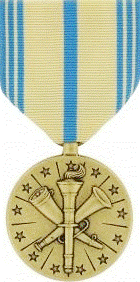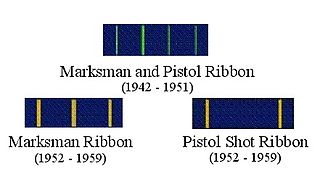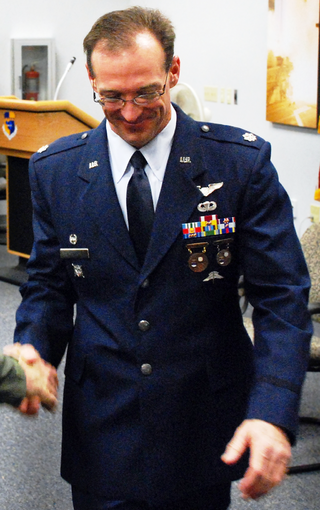
The United States Armed Forces awards and decorations are primarily the medals, service ribbons, and specific badges which recognize military service and personal accomplishments while a member of the U.S. Armed Forces. Such awards are a means to outwardly display the highlights of a service member's career.

A marksmanship ribbon is a United States Navy, Air Force, Space Force, and Coast Guard award that is issued to its members who pass a weapons qualification course and achieve an above-average score. Additionally, there are select state National Guard organizations that award marksmanship ribbons for high placement in state-level marksmanship competitions.
A "V" device is a metal 1⁄4-inch (6.4 mm) capital letter "V" with serifs which, when worn on certain decorations awarded by the United States Armed Forces, distinguishes an award for heroism or valor in combat instead of for meritorious service or achievement.

A 5⁄16 inch star (9.7mm) is a miniature gold or silver five-pointed star that is authorized by the United States Armed Forces as a ribbon device to denote subsequent awards for specific decorations of the Department of the Navy, Coast Guard, Public Health Service, and National Oceanic and Atmospheric Administration. A gold star indicates a second or subsequent decoration, while a silver star is worn in lieu of five gold stars.

In the United States (U.S.), a marksmanship badge is a U.S. military badge or a civilian badge which is awarded to personnel upon successful completion of a weapons qualification course or high achievement in an official marksmanship competition. The U.S. Army and the U.S. Marine Corps are the only military services that award marksmanship qualification badges. However, marksmanship medals and/or marksmanship ribbons are awarded by the U.S. Navy, U.S. Coast Guard, and U.S. Air Force for weapons qualifications. For non-military personnel, different U.S. law enforcement organizations and the National Rifle Association (NRA) award marksmanship qualification badges to those involved in law enforcement. Additionally, the Civilian Marksmanship Program (CMP) and the NRA award marksmanship qualification badges to U.S. civilians. Most of these organizations and the U.S. National Guard award marksmanship competition badges to the people they support who succeed in official competitions.

The Armed Forces Reserve Medal (AFRM) is a service medal of the United States Armed Forces that has existed since 1950. The medal recognizes service performed by members of the reserve components and is awarded to both officers and enlisted personnel. The medal is considered a successor award to the Naval Reserve Medal and the Marine Corps Reserve Ribbon, which were discontinued in 1958 and 1967, respectively.

The diver insignia are qualification badges of the uniformed services of the United States which are awarded to servicemen qualified as divers. Originally, the diver insignia was a cloth patch decoration worn by United States Navy divers in the upper-portion of the enlisted service uniform's left sleeve during the first part of World War II, when the rating insignia was worn on the right sleeve. When enlisted rating insignia were shifted to the left sleeve in late World War II, the patch shifted to the upper right sleeve. The diving patch was created during World War II, and became a breast insignia in the late 1960s.

The Recruiter Badge is a decoration of the United States uniformed services that is awarded to personnel who have performed recruitment duties as service recruiters. The Recruiter Badge is issued by every branch of the U.S. uniform services except for the Marine Corps and the NOAA Commissioned Corps. With the exception of the U.S. Army, a Recruiting Service Ribbon is also awarded to those personnel who have completed successful tours as recruiters.

The U.S. military issues instructor badges to specially training military personnel who are charged with teaching military recruits the skills they need to perform as members of the U.S. Armed Forces or teach continuing education courses for non-commissioned officers and officers in the military. With the exception of the U.S. Army and U.S. Coast Guard, these badges are considered temporary military decorations and must be surrendered upon completion of one's duty as a military instructor. Because of this, the U.S. Air Force, U.S. Navy and U.S. Marine Corps award Drill Instructor Ribbons as a permanent decoration to recognize service members who have qualified and performed as military instructors.

The Marksmanship Medal is a United States Navy and the U.S. Coast Guard military award and is the highest award one may receive for weapons qualification. The Marksmanship Medal is the equivalent of the Expert Marksmanship Badge in the U.S. Army and U.S. Marine Corps. Additionally, select State National Guard organizations award marksmanship medals to guardsmen who achieve some of the highest aggregate scores at state-level marksmanship competitions.

The Distinguished Marksmanship Ribbon was a United States Navy military award which was established in 1942 as the Distinguished Marksman and Pistol Shot Ribbon. The ribbon recognized those who had been presented a Distinguished Marksman Badge through exceptional scoring at a professional military shooting competition. The Distinguished Marksman and Pistol Shot Ribbon was issued for receipt of either a Rifle or Pistol Distinguished Marksman Badge.

Identification badges of the Uniformed Services of the United States are insignia worn by service members conducting special duties, many of which can be awarded as permanent decorations if those duties are performed successfully. There are a few identification badges that are awarded to all services, others are specific to a uniform service. The Office of the President and Vice President and department/service headquarters badges are permanent decorations for those who successfully serve in those assignments. Some of the service level identification badges can be permanent decorations and others are only worn by a service member while performing specific duties, such as the Military Police Badge.

Badges of the United States Army are military decorations issued by the United States Department of the Army to soldiers who achieve a variety of qualifications and accomplishments while serving on active and reserve duty in the United States Army.

Insignias and badges of the United States Navy are military badges issued by the United States Department of the Navy to naval service members who achieve certain qualifications and accomplishments while serving on both active and reserve duty in the United States Navy. Most naval aviation insignia are also permitted for wear on uniforms of the United States Marine Corps.

Badges of the United States Air Force are specific uniform insignia authorized by the United States Air Force that signify aeronautical ratings, special skills, career field qualifications, and serve as identification devices for personnel occupying certain assignments.

Obsolete badges of the United States military are a number of U.S. military insignia which were issued in the 20th and 21st centuries that are no longer used today. After World War II many badges were phased out of the United States Armed Forces in favor of more modern military badges which are used today.

Insignia and badges of the United States Marine Corps are military "badges" issued by the United States Department of the Navy to Marines who achieve certain qualifications and accomplishments while serving on both active and reserve duty in the United States Marine Corps.

The Civilian Marksmanship Program (CMP) is a U.S. government-chartered program intended to promote firearm safety training and safe rifle practice for all U.S. citizens, with a specific emphasis on youth. Any U.S. citizen not otherwise legally prohibited from owning a firearm may purchase a military surplus rifle from the CMP, provided they are a member of a CMP-affiliated club. The CMP operates through a network of affiliated private organizations, shooting clubs, and state associations across every state in the U.S which variously offer firearms safety training and marksmanship courses as well as continued practice and competition events.

The President's Hundred Tab/Brassard is a badge awarded by the Civilian Marksmanship Program (CMP) to the 100 top-scoring military and civilian shooters in the President's Pistol and President's Rifle Matches. The tab is authorized for wear on military uniforms of the U.S. Army, U.S. Air Force, and U.S. Coast Guard. The brassard version is authorized for wear on enlisted uniforms of the U.S. Navy. The tab is 4+1⁄4 inches (11 cm) long and 5⁄8 inch (1.6 cm) high, with the word "PRESIDENT'S HUNDRED" centered in 1⁄4 inch (0.64 cm) tall letters. The Army's and Air Force's miniature metal replica of the tab is a full-color variant of the tab once authorized for wear on the old Army Green Service Uniform and is about 2 inches (5.1 cm) in width. The brassard is a 3+1⁄2 inches (8.9 cm) long by 1 inch (2.5 cm) high curved bronze metallic arm patch with an enameled representation of the flag of the president of the United States flanked by the seal of the president of the United States to the left and the seal of the CMP to the right. At the top of the brassard are the raised words “PRESIDENT’S” to the left and “HUNDRED” to the right.

In the United States Army, tabs are cloth and/or metal arches displaying a word or words signifying a special skill that are worn on U.S. Army uniforms. On the Army Combat Uniform and Army Service Uniform, the tabs are worn above a unit's shoulder sleeve insignia (SSI) and are used to identify a unit's or a soldier's special skill(s) or are worn as part of a unit's SSI as part of its unique heritage. Individual tabs are also worn as small metal arches above or below medals or ribbons on dress uniforms.


















